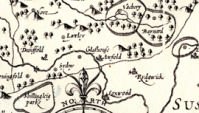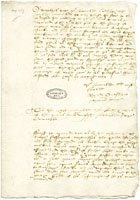By the 1500s, Chiddingfold and the surrounding area was already noted for its excellent natural resources for the manufacture of glass: the ground is very sandy, and there is considerable firewood from the woodlands. However, the industry was very small scale and centred mainly on vessel production. In the mid-16th century, the influx of French Protestant refugees, known as Huguenots, fleeing persecution, brought a wave of glassmakers who settled in Chiddingfold and the surrounding areas. This wave brought new technologies and techniques that greatly improved the industry in the area, including the production of coloured glass.
One of these refugees, who is credited with the re-establishment of window glass production in England, was Jean Carré, born in the Artois region of France around 1520. Carré learned his trade in Antwerp, Belgium, before moving to England by 1567.  He was determined to make window glass in the Weald, and petitioned the state to provide him and his partner, Anthony Becku, for a monopoly on glass production. In 1567, they were issued a monopoly on window glass production in the Lorraine or Norman manner for 21 years on the proviso that they trained Englishmen in this skill. Carré built two glass furnaces in Fernfold, on the Sussex-Surrey border, and one in Sidney Wood in Surrey, near Alfold. In John Speed's 1610 map (reference M/555/1), there is a glasshouse depicted near Alfold. It is assumed Carré lived near to the furnaces he had in Fernfold. Another furnace was built in London and was to focus on Venetian influenced glassware. The techniques Carré brought with him were to have a lasting effect and improvement upon Wealden glass, and his enterprise was carried on by the French refugee glassmakers he introduced.
He was determined to make window glass in the Weald, and petitioned the state to provide him and his partner, Anthony Becku, for a monopoly on glass production. In 1567, they were issued a monopoly on window glass production in the Lorraine or Norman manner for 21 years on the proviso that they trained Englishmen in this skill. Carré built two glass furnaces in Fernfold, on the Sussex-Surrey border, and one in Sidney Wood in Surrey, near Alfold. In John Speed's 1610 map (reference M/555/1), there is a glasshouse depicted near Alfold. It is assumed Carré lived near to the furnaces he had in Fernfold. Another furnace was built in London and was to focus on Venetian influenced glassware. The techniques Carré brought with him were to have a lasting effect and improvement upon Wealden glass, and his enterprise was carried on by the French refugee glassmakers he introduced.
 In 1568, two of Carré's workmen and Becku's son had a dispute that resulted in a fine for the workmen, and the end of Becku and Carré's partnership. In our archive, we have a series of letters that relate to Carré, and his argument with Becku (reference LM/COR/3/108-109, 6729/9/86). Although this was a violation of the patent they had been issued, Carré was given permission to continue as his enterprise was seen as a great source of revenue, and it flourished well past his death on 27 May 1572. His death is recorded as 'John Tarry. Mr. of the Glashouse was buried at Awfolde [sic]' in the Wisborough Green parish records, held at West Sussex Record Office. However, Carré is believed to have been buried in the churchyard of St Nicholas Church in Alfold, Surrey, even though no gravestone was erected. In 1924, the church organist placed a slab of Sussex marble on the presumed grave, detailing it as Carré's.
In 1568, two of Carré's workmen and Becku's son had a dispute that resulted in a fine for the workmen, and the end of Becku and Carré's partnership. In our archive, we have a series of letters that relate to Carré, and his argument with Becku (reference LM/COR/3/108-109, 6729/9/86). Although this was a violation of the patent they had been issued, Carré was given permission to continue as his enterprise was seen as a great source of revenue, and it flourished well past his death on 27 May 1572. His death is recorded as 'John Tarry. Mr. of the Glashouse was buried at Awfolde [sic]' in the Wisborough Green parish records, held at West Sussex Record Office. However, Carré is believed to have been buried in the churchyard of St Nicholas Church in Alfold, Surrey, even though no gravestone was erected. In 1924, the church organist placed a slab of Sussex marble on the presumed grave, detailing it as Carré's.
French and Huguenot refugees continued to work in the Wealden area long past his death, as the Wisborough Green parish records contain at least 26 entries of French families in the area, from 1567 to 1617. The entries then stop rather abruptly, which is probably due to the glassmaking industry away moving from Surrey as a result of James I's Royal Proclamation in 1615. 'A Proclamation touching glass' prohibited the burning of wood fuel for glassmaking, as wood was considered more important for other uses. As the industry began to utilise other fuels, it relocated to areas where coal was accessible.
Select images to view larger versions.

